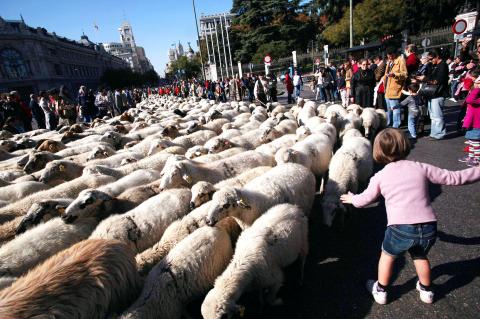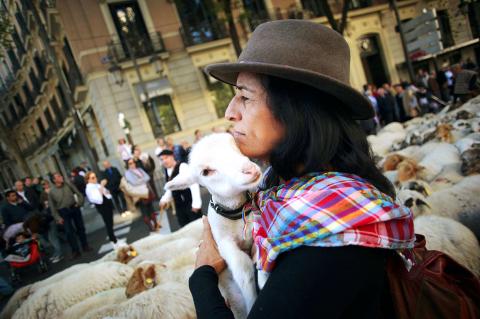Just as in the Middle Ages, flocks of sheep and herds of cows made their way through Madrid city center last Sunday, marking the centuries-old annual tradition of transhumance, in which cattle migrate from summer to winter pastures.
Thousands of bleating sheep that had left the mountains of the north or the hot plains of the south, found their way through the city streets no differently than they would a rural hamlet.
“Transhumance is still practiced by herds coming down from the north heading towards the fields of Castile,” cattle farmer Vanesa Sanchez said as she accompanied her cows.

Photo: Reuters
照片:路透
Sunday’s festival is “a reminder that Madrid was and still is on a transhumance pathway,” she said as shepherds whistled around her, directing their livestock down Madrid’s historic avenues.
“These ones come from Colmenar Viejo, about 20km north of Madrid,” explained farmer Geronimo Garcia, pointing to a few beasts as they left the Puerta del Sol, the capital city’s most famous square.
Another herd came all the way from La Rioja, hundreds of kilometers away, ”using only the old transhumance routes,” Garcia said.

Photo: Reuters
照片:路透
Several of these routes still exist in Spain, criss-crossing the country over more than 120,000km, though few of them still serve their traditional purpose.
Every year for centuries, three to five million sheep transited through these transhumance trails, often paying tolls to cross towns and mountain passages.
In memory of these ancient levies, a shepherd last Sunday paid a Madrid official 160 maravedies, a medieval currency.
A group of shepherds whistling after three dogs opened the parade that attracted crowds of locals and tourists.
To organizers from the association of Transhumance and Nature, the goal of the day is to help preserve the ancient routes and pass on a tradition to the younger generation.
(AFP)
上週日上演羊群與牛群穿越馬德里市中心,以慶祝自古流傳至今畜牧群季節性移動,牛隻從夏季放牧地遷移到冬季放牧地的傳統,場面好比置身中世紀。
上千頭已離開北方山脈或是南部炎熱平原的咩咩叫綿羊,與行經鄉下村落沒兩樣,就這麼大剌剌地在城市街道踩街。
養牛農夫凡妮莎‧桑切斯在其牛隻伴隨下表示:「將畜牧群從北方高原趕往卡斯提爾牧場的畜牧群季節性移動,仍流傳至今。」
就在幾位牧羊人在桑切斯周圍吹著口哨,引領各自家畜前往馬德里歷史上著名的街道時,她表示,週日的慶典目的是要「保留馬德里曾經且至今仍舊是個畜牧季節性移動中繼站的傳統,不被遺忘。」
正當動物們離開該首都最著名的廣場太陽門時,農夫傑洛尼姆‧賈西亞指著一些體格壯碩的動物解釋道:「這些是從離馬德里北方二十公里的科梅納爾比艾霍來的。」
賈西亞表示,另外一批牧群,則是從數百公里遠的拉里奧哈來的,牠們「只走古代畜牧群季節性移動的行進路線。」
許多西班牙境內縱橫交錯超過十二萬公里的遊牧路線,至今猶存,但僅少數仍延續其原始傳統的用途。
自古以來年復一年,三百萬至五百萬頭羊穿過這些畜牧群季節性移動的路線,並且經常支付跨城與跨山路的通行費。
為回溯這項古代通行費的傳統,一位牧羊人上週日付給馬德里官員一百六十馬拉維迪幣,這是一種在中世紀使用的貨幣。
一群在三隻狗兒後吹著口哨的牧羊人,為這場吸引大批當地民眾與觀光客的游牧家畜街頭大遊行,揭開序幕。
對於策劃該活動的畜牧群季節移動與自然協會而言,該日活動的宗旨是要幫助保存古老游牧路線,以及將傳統傳承給年輕世代。
(法新社/翻譯:林亞蒂)

If you’ve recently spotted adults parading around with cuddly toys dangling from their designer handbags, your eyes haven’t been deceiving you. The playful trend of adorning bags with cute charms has become popular among people of various ages. Plushies like Labubu and anime and manga characters such as Chiikawa have become must-have accessories that make personal statements. The practice of attaching charms to personal items has been common across cultures throughout history. In ancient civilizations, charms were often used as symbols of protection, good luck, or identity. Fast-forward to more modern times, and style icons like Jane Birkin, a

A: So you’re reading Jin Yong’s martial arts novel again? B: Yup, Jin’s novels are so fascinating, especially the trilogy: “Legends of the Condor Heroes,” “Return of the Condor Heroes,” and “Heaven Sword and Dragon Saber.” A: The late novelist published his first story in 1955, which means this year marks the 70th anniversary of his “wuxia” world. B: Wasn’t an English version of “Legends of the Condor Heroes” also released in 2018? A: Yes, but the debate over the translation of kung fu moves continues — like the evil move “Nine Yin Skeleton Claw.” A: 你又在重讀金庸的武俠小說啦? B:

A: Apart from Jin Yong, the late martial arts novelists Liang Yusheng and Gu Long were also very popular. B: Wasn’t Liang a pioneer of the “new school” wuxia genre in the 20th century? A: Yup, I really like his Tianshan mountain series. All the characters — such as the “White Haired Demoness” — are so vivid. B: The roles in Gu’s books are lively, too — like the “Fragrant Commander” Chu Liuxiang. A: And the TV drama adapted from the Chu Liuxiang series swept across Taiwan in the 1980s, with ratings surging over 70 percent at that time.

Continued from yesterday(延續自昨日) https://www.taipeitimes.com/News/lang If plushie charms are cute little nods to people’s interests, ita bags are full-on declarations. The term “ita” comes from the Japanese word itai, which means “painful” and reflects the overwhelming visual intensity of these bags. An ita bag is essentially a handbag, backpack, or tote meticulously decorated with an extensive collection of merchandise dedicated to a specific character or idol. These bags usually feature a clear plastic window to display carefully arranged pins, badges, keychains, or fan art. Both the interior and exterior may be covered in fandom memorabilia, creating an aesthetic so intense that it’s almost “painful”